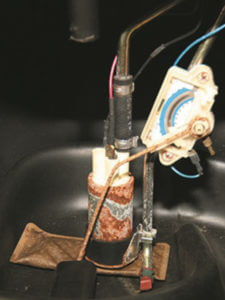Causes of fuel pump failure
What causes fuel pump failure?
If your fuel pump just bit the dust, you’re probably wondering what causes fuel pump failure. The fuel pump on a fuel injected vehicle is located inside the gas tank. It’s there for a reason. These pumps are powered by an electric motor and engineers place the pump in the tank so the electric motor can be cooled by the gasoline. You would think that placing the pump in the tank is a bad design because you’d have to drop the tank just to change a fuel pump. That’s not how the engineers see it. That’s because they’re designed the pump to last the life of the vehicle.
Running low on fuel is the #1 cause or fuel pump failure
Repeatedly running your vehicle when it’s low on fuel deprives the fuel pump of the cooling it needs to prevent premature wear. If you constantly drive around with less than ¼ tank, don’t be surprised that your fuel pump fails early.
Dirt and rust contamination is the #2 cause of fuel pump failure.
Yes, the fuel pump module contains a filter sock, but if you

Rusty tank and fuel pump
have an old rusty tank with dirt and rust particles, they can get sucked into the pump and wear out the impeller.
What wears out on a fuel pump?
The early fuel injected fuel pumps were brushed DC motors. Brushed motors generate approximately 100°F heat near the armature. So the engineers rely on the colder fuel in the tank to dissipate this heat. When you run the vehicle with low fuel, the brushes overheat and deposit carbon particles on the copper armature contacts. This carbon buildup increases electrical resistance, which reduces the motor’s power. Once the resistance get high enough, the pump can’t build enough fuel pressure to supply the fuel injectors.
The carbon deposits also create heat in the electrical connectors, sometimes causing the plastic components to melt.
Dirt and debris also clog the check valve
Electric fuel pumps contain a check valve to prevent the fuel from draining back into the tank. However, if dirt and rust get caught in the check valve, you’ll experience much longer cranking times as the fuel pump must build up pressure from scratch.
Also, when fuel drains down to the tank, the remaining fuel is no longer under pressure, so it’s vulnerable to causing vapor lock.
Testing for leak down
When the check valve fails, the fuel rail loses pressure. All fuel rails lose some pressure immediately after engine shutdown, but the remaining pressure should remain steady after 5-mins. To be within spec, fuel rail pressure should never fall below 20-psi within 20-mins after shutdown.
©, 2018 Rick Muscoplat
Posted on by Rick Muscoplat